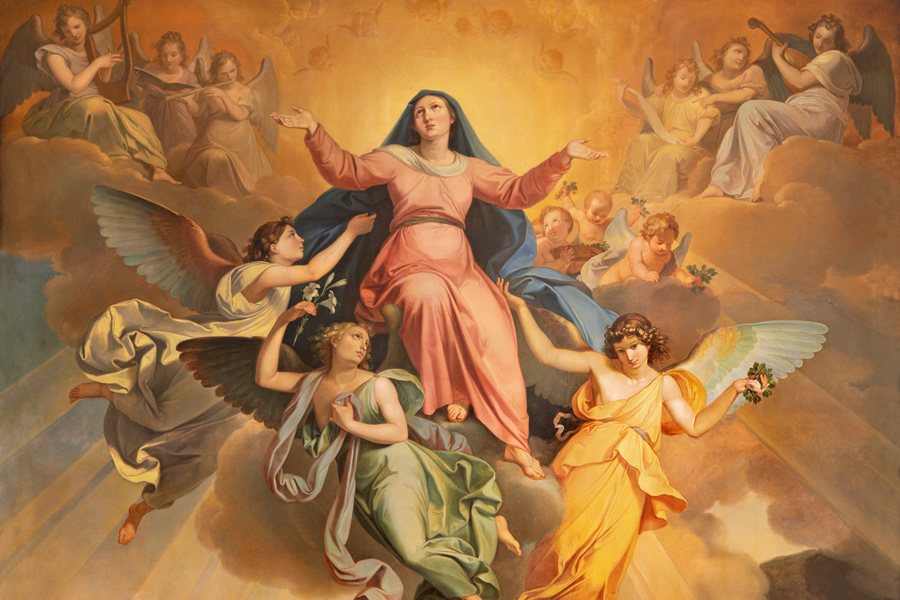Blog & Pastor Letters

Solemnity of the Assumption of the Blessed Virgin Mary into Heaven
08-15-2021Weekly ReflectionRev. Wilfred YinahTHE ASSUMPTION OF MARY’S BODY INTO HEAVEN - With these few words, the Church gave its authoritative teaching to the millions who for generations had believed that Mary’s body was incorruptible but had waited for the declaration to be made by the Vatican. The doctrine of the Assumption was defined as a dogma of faith by Pope Pius XII on November 1st, 1950, in Munificentissimus Deus. While the bodies of the Apostles and martyrs could be preserved and venerated, whereas of the body of Mary, no relic should remain on earth.
Mary shares with her divine Son the unity of body and soul after earthly life, and in so doing they both help us to anticipate that moment of our own, when our souls and heavenly bodies will once again be reunited at the end of time. This is the wonderful assurance that God has given us through revelation, as well as through tradition, giving us such confidence in the resurrection of the body, and in the re-unification of body and soul in the life to come. The resurrection of Christ proclaims that his body did not know decay. The Assumption of Mary proclaims the same truth. Mary was taken up to be where Christ is: ‘where I am you may be also.’ (Jn.14.3) Mary’s assumption is dependent upon the ascension of Jesus. Mary is related to her son through the grace of election and purity which she enjoyed from the first moment of her creation. Being without sin the relationship of obedient love was never broken. She also enjoyed the relationship of maternity. He grew in her womb; they shared a common life: they were of ‘one flesh’. In the resurrection it is the flesh of Christ that ascends to heavenly glory. At the end of her earthly life, it is Mary’s body, in which the redeemer of the world was received and nourished, which is re-united with the glorified Christ. It is reunited, but it was never separated.
As we celebrate this transition of Our Blessed Lady to be reunited with her divine son, we can be completely convinced of the role she plays as our heavenly mother. In His goodness, God chose his Son’s sinless earthly mother to continue Christ’s earthly ministry, as the Queen of Heaven. But the role of Mary, heavenly mother of the whole human race, and mother of the Eternal King of the Universe, is surely not simply a title that signifies nothing more than a mental impression of Mary’s Assumption into the presence of God but indicates so much more: it is as a sign of hope for us now in the 21st Century as it has been for two thousand years.
Pope Francis writes about ‘a Marian style’ to the Church’s work of evangelization. This itself is an indication of how we might contemplate the part that Mary contributes to her divine Son’s mission of salvation. It is, as the Pope describes, ‘Mary’s revolutionary nature of love and tenderness’. In her, the Pope says, we begin to understand that ‘humility and tenderness are not virtues of the weak but of the strong, who need not treat others poorly in order to feel important themselves.
This woman, our Lady, was given to St John by Jesus from the cross to be our mother, Pope Francis writes, ‘walks as a true mother at our side, sharing our struggles and opening our hearts to faith, surrounding us with God’s love’. If the world can recognize Mary as our heavenly mother, we can allow ourselves to be led by her. In times of trial in the world, Mary has always been close at hand, always sharing the sufferings of her human family on earth. Never was this more evident than when Our Lady appeared to her children at Lourdes, at Fatima and at other Marian shrines, indicating her real concern for the anxieties of Christ’s flock. As she took on the role of our mother at the foot of the cross, Mary accepted that the whole of mankind needs to turn to her for consolation, seeking her to lead us closer to her divine son. And there is no time better than the present.
BACK TO LIST